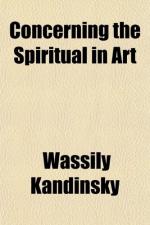This essential connection between colour and form brings us to the question of the influences of form on colour. Form alone, even though totally abstract and geometrical, has a power of inner suggestion. A triangle (without the accessory consideration of its being acute-or obtuse-angled or equilateral) has a spiritual value of its own. In connection with other forms, this value may be somewhat modified, but remains in quality the same. The case is similar with a circle, a square, or any conceivable geometrical figure. [Footnote: The angle at which the triangle stands, and whether it is stationary or moving, are of importance to its spiritual value. This fact is specially worthy of the painter’s consideration.] As above, with the red, we have here a subjective substance in an objective shell.
The mutual influence of form and colour now becomes clear. A yellow triangle, a blue circle, a green square, or a green triangle, a yellow circle, a blue square—all these are different and have different spiritual values.
It is evident that many colours are hampered and even nullified in effect by many forms. On the whole, keen colours are well suited by sharp forms (e.g., a yellow triangle), and soft, deep colours by round forms (e.g., a blue circle). But it must be remembered that an unsuitable combination of form and colour is not necessarily discordant, but may, with manipulation, show the way to fresh possibilities of harmony.
Since colours and forms are well-nigh innumerable, their combination and their influences are likewise unending. The material is inexhaustible.
Form, in the narrow sense, is nothing but the separating line between surfaces of colour. That is its outer meaning. But it has also an inner meaning, of varying intensity, [Footnote: It is never literally true that any form is meaningless and “says nothing.” Every form in the world says something. But its message often fails to reach us, and even if it does, full understanding is often withheld from us.] and, properly speaking, form is the outward expression of this inner meaning. To use once more the metaphor of the piano—the artist is the hand which, by playing on this or that key (i.e., form), affects the human soul in this or that way. So it is evident that form-harmony must rest only on A corresponding vibration of the human soul; and this is A second guiding principle of the inner need.
The two aspects of form just mentioned define its two aims. The task of limiting surfaces (the outer aspect) is well performed if the inner meaning is fully expressed.
[Footnote: The phrase “full expression” must be clearly understood. Form often is most expressive when least coherent. It is often most expressive when outwardly most imperfect, perhaps only a stroke, a mere hint of outer meaning.]




